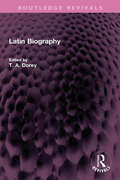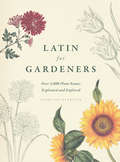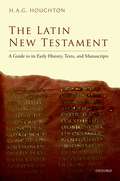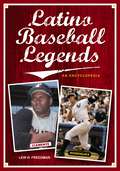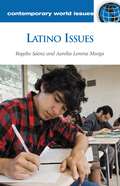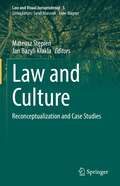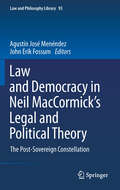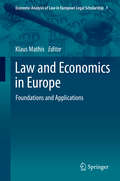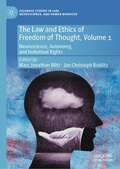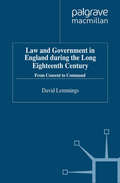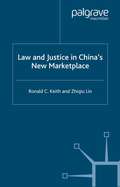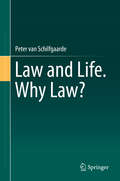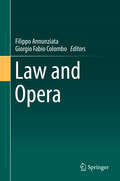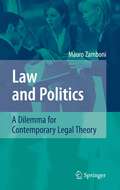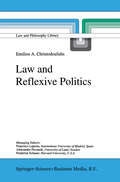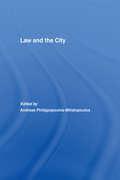- Table View
- List View
Latin Biography (Routledge Revivals)
First published in 1967, Latin Biography contains chapters on Nepos, Plutarch and Suetonius, the three best-known Classical biographers. There are also accounts of the less-familiar works of Q. Curtius Rufus and the author – or authors – of the Historia Augusta, and three chapters deal with the development of Latin biography in the Middle Ages. The Middle Ages were indebted to Suetonius, Shakespeare to Plutarch, Gibbon to the Historia Augusta. Since the Renaissance their methods have gradually been superseded by a more critical and scientific approach, but the ancient biographers can always claim the credit for having established biography as a major form of literature. This book will be of interest to students of literature and classical studies.
Latin for Gardeners: Over 3,000 Plant Names Explained and Explored
by Lorraine HarrisonSince Latin became the standard language for plant naming in the eighteenth century, it has been intrinsically linked with botany. And while mastery of the classical language may not be a prerequisite for tending perennials, all gardeners stand to benefit from learning a bit of Latin and its conventions in the field. Without it, they might buy a Hellebores foetidus and be unprepared for its fetid smell, or a Potentilla reptans with the expectation that it will stand straight as a sentinel rather than creep along the ground. An essential addition to the gardener’s library, this colorful, fully illustrated book details the history of naming plants, provides an overview of Latin naming conventions, and offers guidelines for pronunciation. Readers will learn to identify Latin terms that indicate the provenance of a given plant and provide clues to its color, shape, fragrance, taste, behavior, functions, and more. Full of expert instruction and practical guidance, Latin for Gardeners will allow novices and green thumbs alike to better appreciate the seemingly esoteric names behind the plants they work with, and to expertly converse with fellow enthusiasts. Soon they will realize that having a basic understanding of Latin before trips to the nursery or botanic garden is like possessing some knowledge of French before traveling to Paris; it enriches the whole experience.
The Latin New Testament: A Guide to its Early History, Texts, and Manuscripts
by H. A. HoughtonLatin is the language in which the New Testament was copied, read, and studied for over a millennium. The remains of the initial 'Old Latin' version preserve important testimony for early forms of text and the way in which the Bible was understood by the first translators. Successive revisions resulted in a standard version subsequently known as the Vulgate which, along with the creation of influential commentaries by scholars such as Jerome and Augustine, shaped theology and exegesis for many centuries. Latin gospel books and other New Testament manuscripts illustrate the continuous tradition of Christian book culture, from the late antique codices of Roman North Africa and Italy to the glorious creations of Northumbrian scriptoria, the pandects of the Carolingian era, eleventh-century Giant Bibles, and the Paris Bibles associated with the rise of the university. In The Latin New Testament, H.A.G. Houghton provides a comprehensive introduction to the history and development of the Latin New Testament. Drawing on major editions and recent advances in scholarship, he offers a new synthesis which brings together evidence from Christian authors and biblical manuscripts from earliest times to the late Middle Ages. All manuscripts identified as containing Old Latin evidence for the New Testament are described in a catalogue, along with those featured in the two principal modern editions of the Vulgate. A user's guide is provided for these editions and the other key scholarly tools for studying the Latin New Testament.
The Latin New Testament: A Guide to its Early History, Texts, and Manuscripts
by H. A. HoughtonThis is an open access title available under the terms of a CC BY-NC-ND 4.0 licence. It is free to read at Oxford Scholarship Online and offered as a free PDF download from OUP and selected open access locations. Latin is the language in which the New Testament was copied, read, and studied for over a millennium. The remains of the initial 'Old Latin' version preserve important testimony for early forms of text and the way in which the Bible was understood by the first translators. Successive revisions resulted in a standard version subsequently known as the Vulgate which, along with the creation of influential commentaries by scholars such as Jerome and Augustine, shaped theology and exegesis for many centuries. Latin gospel books and other New Testament manuscripts illustrate the continuous tradition of Christian book culture, from the late antique codices of Roman North Africa and Italy to the glorious creations of Northumbrian scriptoria, the pandects of the Carolingian era, eleventh-century Giant Bibles, and the Paris Bibles associated with the rise of the university. In The Latin New Testament, H. A. G. Houghton provides a comprehensive introduction to the history and development of the Latin New Testament. Drawing on major editions and recent advances in scholarship, he offers a new synthesis which brings together evidence from Christian authors and biblical manuscripts from earliest times to the late Middle Ages. All manuscripts identified as containing Old Latin evidence for the New Testament are described in a catalogue, along with those featured in the two principal modern editions of the Vulgate. A user's guide is provided for these editions and the other key scholarly tools for studying the Latin New Testament.
Latina and Latino Children's Mental Health [2 volumes]: [2 volumes] (Child Psychology and Mental Health)
by Natasha J. Cabrera Francisco A. Ph.D. Hiram E. FitzgeraldA team of expert academics and practitioners examines the life circumstances that impact Latino/a youth growing up in two cultures—their native culture and that of the United States.What effect does growing up in an ethnic minority and perhaps in an immigrant family have on development? That is the overarching question Latina and Latino Children's Mental Health sets out to answer. The work examines all of the myriad physical, psychological, social, and environmental factors that undermine or support healthy development in Latino American children, from biology to economics to public policy. The first volume of this two-volume set focuses on early-life experiences and the second on youth/adolescent issues, treating such topics as children's development of a sense of self, development of linguistic skills, peer relationships, sexual orientation, and physical development. The work analyzes familial relationships, often an important resource that helps young people build resilience despite the stresses of migration. And it looks at patterns of behavior, social status, and social-goal orientations that differentiate Latino/a children and adolescents from their African American and European American peers.
Latina/o Healing Practices: Mestizo and Indigenous Perspectives
by Brian McNeill Jose M. CervantesThis edited volume focuses on the role of traditional or indigenous healers, as well as the application of traditional healing practices in contemporary counseling and therapeutic modalities with Latina/o people. The book offers a broad coverage of important topics, such as traditional healer’s views of mental/psychological health and well-being, the use of traditional healing techniques in contemporary psychotherapy, and herbal remedies in psychiatric practice. It also discusses common factors across traditional healing methods and contemporary psychotherapies, the importance of spirituality in counseling and everyday life, the application of indigenous healing practices with Latina/o undergraduates, indigenous techniques in working with perpetrators of domestic violence, and religious healing systems and biomedical models. The book is an important reference for anyone working within the general field of mental health practice and those seeking to understand culturally relevant practice with Latina/o populations.
Latina/o Healing Practices: Mestizo and Indigenous Perspectives
by Brian W. McNeillThis edited volume focuses on the role of traditional or indigenous healers, as well as the application of traditional healing practices in contemporary counseling and therapeutic modalities with Latina/o people. The book offers a broad coverage of important topics, such as traditional healer’s views of mental/psychological health and well-being, the use of traditional healing techniques in contemporary psychotherapy, and herbal remedies in psychiatric practice. It also discusses common factors across traditional healing methods and contemporary psychotherapies, the importance of spirituality in counseling and everyday life, the application of indigenous healing practices with Latina/o undergraduates, indigenous techniques in working with perpetrators of domestic violence, and religious healing systems and biomedical models. The book is an important reference for anyone working within the general field of mental health practice and those seeking to understand culturally relevant practice with Latina/o populations.
Latino Baseball Legends: An Encyclopedia
by Lew FreedmanTold through profiles of the men who have made it a reality, this is the complex story of the triumphs achieved by—and challenges faced by—Latinos who have risen to the heights of Major League Baseball.Latino Baseball Legends: An Encyclopedia offers the most comprehensive, go-to source for everything relating to Latin American baseball stars, tracing the history of Latinos in baseball through the stories of those who have excelled at the game. Colorfully written 3,000-word entries explore the lives and careers of 25 dominant players, from legends such as Roberto Clemente to deserving, but comparatively unknown superstars such as Martin Dihigo. Shorter listings note another 75 Latinos who have figured prominently in the sport. The entries document the importance of baseball in Latin American culture and the way it has evolved in the players' home countries, but the encyclopedia does more than that. Its profiles also expose the difficulties faced by Latino players who are forced to overcome both a language barrier and the discrimination they face because of their skin color. And they demonstrate how proficiency with a bat and ball has become a great engine that can lift families out of poverty and provide hope for indigent youths.
Latino Issues: A Reference Handbook (Contemporary World Issues)
by Rogelio Saenz Ph.D. Aurelia Lorena MurgaThis book provides a lively understanding of the growing Latina/o population in the United States, highlights the problems that confront this ethnic group, and discusses proposed solutions to these issues.The groups that comprise the Latina/o population differ with respect to histories, length of residence in the United States, mode in which they originally came to this country, and trajectory of integration. Latinos in America: A Reference Handbook provides a comprehensive overview of Latina/o experiences in the United States from historical and contemporary perspectives, illustrating the diversity of this disparate population. The handbook covers numerous aspects of Latino life in the United States, engaging readers in current problems and controversies involving the Latino population and suggesting solutions. Profiles of prominent Latina/os are included, as is information on legal/illegal immigration, bilingual education, affirmative action, dual citizenship, and assimilation—all of which will prove invaluable to students, as well as to policymakers, educators, and other community leaders interested in improving the lives of Latinos within our borders.
Latino Issues: A Reference Handbook (Contemporary World Issues)
by Rogelio Sáenz Aurelia Lorena MurgaThis book provides a lively understanding of the growing Latina/o population in the United States, highlights the problems that confront this ethnic group, and discusses proposed solutions to these issues.The groups that comprise the Latina/o population differ with respect to histories, length of residence in the United States, mode in which they originally came to this country, and trajectory of integration. Latinos in America: A Reference Handbook provides a comprehensive overview of Latina/o experiences in the United States from historical and contemporary perspectives, illustrating the diversity of this disparate population. The handbook covers numerous aspects of Latino life in the United States, engaging readers in current problems and controversies involving the Latino population and suggesting solutions. Profiles of prominent Latina/os are included, as is information on legal/illegal immigration, bilingual education, affirmative action, dual citizenship, and assimilation—all of which will prove invaluable to students, as well as to policymakers, educators, and other community leaders interested in improving the lives of Latinos within our borders.
Laurence Sterne and the Visual Imagination
by W.B. GerardThe first full-length and comprehensive study of the illustrations of Sterne's work, this book explores the ability of Sterne's texts to inspire the visual imagination. It helps to explain why scores of editions of his fiction have been illustrated, some profusely: to fulfill the reader's desire, as well as the artist's compulsion, to visualize Sterne's words. Gerard places his subject in a clear and innovative theoretical framework which opens the field to general word and image studies. The author begins by examining the distinct varieties of pictorialism in Sterne's texts. The remainder of the study takes into account three remarkable series of illustrations-representing Trim reading the sermon, didactic sentimentalism in A Sentimental Journey and Henry Mackenzie's Man of Feeling, and the many and diverse portrayals of 'poor Maria' - to demonstrate the ways in which culture projects these texts differently through the various artists.
Laurence Sterne and the Visual Imagination
by W.B. GerardThe first full-length and comprehensive study of the illustrations of Sterne's work, this book explores the ability of Sterne's texts to inspire the visual imagination. It helps to explain why scores of editions of his fiction have been illustrated, some profusely: to fulfill the reader's desire, as well as the artist's compulsion, to visualize Sterne's words. Gerard places his subject in a clear and innovative theoretical framework which opens the field to general word and image studies. The author begins by examining the distinct varieties of pictorialism in Sterne's texts. The remainder of the study takes into account three remarkable series of illustrations-representing Trim reading the sermon, didactic sentimentalism in A Sentimental Journey and Henry Mackenzie's Man of Feeling, and the many and diverse portrayals of 'poor Maria' - to demonstrate the ways in which culture projects these texts differently through the various artists.
Law and Culture: Reconceptualization and Case Studies (Law and Visual Jurisprudence #5)
by Mateusz Stępień Jan Bazyli KlaklaDivided into three parts, this book examines the relationship between law and culture from various perspectives, both theoretical and empirical. Part I outlines the framework for further considerations and includes new, innovative conceptualizations of two ideas that are essential to the topic of law and culture: legal culture and customary law. Both of these reappear later in the more empirically oriented chapters of Parts II and III. Part II includes chapters on the relationships between law, customs, and culture, drawing heavily on the tradition and achievements of the anthropology of law and touching on important problems of multiculturalism, legal pluralism, and cultural defense. It focuses on the more intangible meaning of culture, while Part III addresses its more material, tangible aspects and the issue of cultural production, as well as its intersection with law.
Law and Democracy in Neil MacCormick's Legal and Political Theory: The Post-Sovereign Constellation (Law and Philosophy Library #93)
by Agustín José Menéndez and John Erik FossumThis volume offers a collection of articles by leading legal and political theorists. Originally intended as a celebration of MacCormick’s work on the occasion of the completion of the four-volume series on Law, State and Practical Reason, it has turned into a homage and salute after MacCormick’s passing. Cast in MacCormick’s reflexive spirit, the book presents a critical reconstruction of the Scottish philosopher’s work, with the aim of revealing the connections between law and democracy in his writings and furthering his insights in each specific field.Neil MacCormick made outstanding contributions to the understanding of law and democracy under conditions of pluralism. His institutional theory of law has elucidated the close connection between the normative character of law as a means of social integration and legal social practices. This has produced a synthesis of the key insights of the legal and political theories of Kelsen, Hart, Alexy and Dworkin, and has broken new ground by undermining the ‘monolithic’ and ‘nation-state’ centered character of standard legal theories.
Law and Economics in Europe: Foundations and Applications (Economic Analysis of Law in European Legal Scholarship #1)
by Klaus MathisThis anthology illustrates how law and economics is developing in Europe and what opportunities and problems – both in general and specific legal fields – are associated with this approach within the legal traditions of European countries. The first part illuminates the differences in the development and reception of the economic analysis of law in the American Common Law system and in the continental European Civil Law system. The second part focuses on the different ways of thinking of lawyers and economists, which clash in economic analysis of law. The third part is devoted to legal transplants, which often accompany the reception of law and economics from the United States. Finally, the fourth part focuses on the role economic analysis plays in the law of the European Union. This anthology with its 14 essays from young European legal scholars is an important milestone in establishing a European law and economics culture and tradition.
The Law and Ethics of Freedom of Thought, Volume 1: Neuroscience, Autonomy, and Individual Rights (Palgrave Studies in Law, Neuroscience, and Human Behavior)
by Marc Jonathan Blitz Jan Christoph BublitzFreedom of thought is one of the great and venerable notions of Western thought, often celebrated in philosophical texts – and described as a crucial right in American, European, and International Law, and in that of other jurisdictions. What it means more precisely is, however, anything but clear; surprisingly little writing has been devoted to it. In the past, perhaps, there has been little need for such elaboration. As one Supreme Court Justice stressed, “[f]reedom to think is absolute of its own nature” because even “the most tyrannical government is powerless to control the inward workings of the mind.” But the rise of brain scanning, cognition enhancement, and other emerging technologies make this question a more pressing one. This volume provides an interdisciplinary exploration of how freedom of thought might function as an ethical principle and as a constitutional or human right. It draws on philosophy, legal analysis, history, and reflections on neuroscience and neurotechnology to explore what respect for freedom of thought (or an individual’s cognitive liberty or autonomy) requires.
Law and Government in England during the Long Eighteenth Century: From Consent to Command (Studies in Modern History)
by D. LemmingsOver the long eighteenth century English governance was transformed by large adjustments to the legal instruments and processes of power. This book documents and analyzes these shifts and focuses upon the changing relations between legal authority and the English people.
Law and Justice in China's New Marketplace
by Ronald C. KeithLaw and Justice in China's New Marketplace provides the first comprehensive multidisciplinary analysis of the jurisprudence and related law underlying the contemporary Chinese transition to the 'socialist market economy'. New 'pluralized jurisprudence' has moved beyond Marxist class analysis to consider a new balance of values relating to economic efficiency and social justice in the marketplace, and yet the interior debates and perspectives concerning these values are virtually unknown in the Western scholarly literature. By analysing the changing Chinese approach in law to the adjustment of social interests in the context of profound economic change , Law and Justice in China's New Marketplace provides a unique reference tool. It outlines the new vocabulary of market jurisprudence and law and examines new legal thinking on rights protection with reference to widely ranging and often hot internal debate over human rights, property law and procedural or judicial justice.
Law and Life. Why Law?
by Peter van SchilfgaardeThis book is based on the assumption that the world is governed by a widespread field of interconnected laws. In this field man-made laws – legal laws - have to coexist with the laws of nature, the laws of science and the laws of logic. They have to find their place in relation to a certain society. They have to relate to the demands of morality, ethics, custom and trust. They have to follow the laws of language. They have to deal with a variety of professional and esthetic rules. They have to defend their position between art and craft. Finally, and significantly, they have to cope with a host of different ideas about truth. This book approaches law as a human construct meant to strengthen society as it develops through the ages. Knowledge of the law – legal knowledge – is of doubtful value if it ignores the demands and ideals of society. The same goes for the thinking leading to legal knowledge.This book focuses on a basic concept. That concept is met if the legal thinking, leading to legal knowledge, reaches the level of an independent, law and society oriented, contemplative discipline. A discipline which is in that sense and to that extent in touch with - cherished or less cherished - parts of given law.
Law and Opera
by Filippo Annunziata Giorgio Fabio ColomboThis book explores the various connections between Law and Opera, providing a comprehensive, multinational, and multidisciplinary (with approaches from jurists, philosophers, musicologist, historians) resource on the subject. Further, it makes a valuable contribution to studies on law and the humanities. While, for example, the relationship between law and literature has been extensively researched, the relationship between Law and Opera remains largely overlooked. The book approaches the topic from three perspectives in three main sections: Law in Opera, Law on Opera, and Law around Opera.
Law and Politics: A Dilemma for Contemporary Legal Theory
by Mauro ZamboniThis book reconstructs and classifies, according to ideal-typical models, the different positions taken by the major contemporary legal theories as to whether and how law relates to politics. It presents a possible explanation as to why different legal theories, though often reaching diametric results, somehow must still begin from common basic points.
Law and Reflexive Politics (Law and Philosophy Library #35)
by E.A. ChristodoulidisLaw is the great concealer; and law is everywhere. Or so claimed Marxists once upon a time. [Law] was imbricated within the mode of production and productive relations themselves . . . it intruded brusquely within alien categories, re-appearing bewigged and gowned in the form of ideology; . . . it was an arm of politics and politics was one of its arms; it was an academic discipline, subjected to the rigour of its own autonomous logic, it contributed to the definition of the self-identity of both the rulers 1 and the ruled. Does the old critique of domination still hold any sway? Apparently not. Or so even scholars of the far Left keep reminding us in their eagerness to embrace law and proclaim their allegiance to the new constitutional politics of civil society. Old Marxists now describe popular sovereignty as 'co-original' with, and democracy 'internally linked' to 2 constitutional rights and find it hard to remember what it was they once disagreed with liberals about. No tension left between emancipatory politics and oppressive law; instead we have reciprocal constitution, simultaneous realisation. In the Left's embracing of the new constitutionalisms its old critique of law - the critique of the law's concealment of class inequality, class conflict and class action - is left behind.
Law and the City: Theorising Environmental Law And The City (Law, Science And Society Ser.)
by Andreas Philippopoulos-MihalopoulosLaw and the City offers a lateral, critical and often unexpected description of some of the most important cities in the world, including Moscow, Istanbul, Berlin, Singapore, Athens, Mexico City, Toronto, Sydney, Johannesburg: each one from a distinctive legal perspective. An invaluable 'guide' to adopting a different approach to the city and its history, culture and everyday experience, Law and the City is not simply an exploration of the relationship between these two spheres. It details: a flourishing of law’s spatiality and urban legal locality an unfolding of both the juridical urban body and the city’s legal dreams, of both the ‘urban law’ and the ‘juridical polis’. Enlightening and at the same time problematizing the reader, this volume is an innovative collection of truly global dimensions that will prove compelling reading both for specialists and for critical travellers.
Law and the City
by Andreas Philippopoulos-MihalopoulosLaw and the City offers a lateral, critical and often unexpected description of some of the most important cities in the world, including Moscow, Istanbul, Berlin, Singapore, Athens, Mexico City, Toronto, Sydney, Johannesburg: each one from a distinctive legal perspective. An invaluable 'guide' to adopting a different approach to the city and its history, culture and everyday experience, Law and the City is not simply an exploration of the relationship between these two spheres. It details: a flourishing of law’s spatiality and urban legal locality an unfolding of both the juridical urban body and the city’s legal dreams, of both the ‘urban law’ and the ‘juridical polis’. Enlightening and at the same time problematizing the reader, this volume is an innovative collection of truly global dimensions that will prove compelling reading both for specialists and for critical travellers.
Law and the Unconscious: A Legendre Reader (Language, Discourse, Society)
by Pierre LegendreLaw and the Unconscious is the first work of the French legal philosopher Pierre Legendre to appear in English. Trained as a lawyer, a historian and a psychoanalyst, the work of Pierre Legendre has consistently confronted law with the teaching and methods of psychoanalysis. The present collection of essays addresses a fascinating and diverse set of themes including the doctrinal regulation of tears, dance and law, the desire for the absolute, the war of texts, and the power of images.
